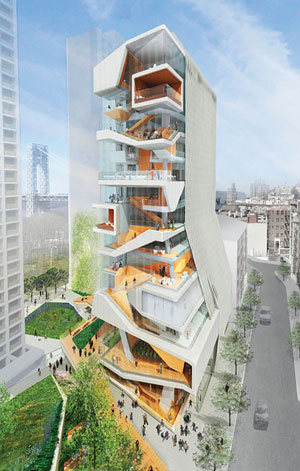Trending
The ‘façade’ of Columbia’s new medical
The school’s new Washington Heights building fails to live up to its promise

Between the lovely architectural rendering and the finished building falls the shadow. Creations that look beautiful and stylish on paper, that seem to make eminent aesthetic sense, often turn up stillborn under the glare of an Upper Manhattan noon.
Columbia University’s Medical and Graduate Education Building in Washington Heights is a case in point. The renderings for the 15-story, 107,299-square-foot building — which will house classrooms and other academic facilities — have been attracting the attention of architectural aficionados on the Internet for several years now.
Designed by the prolific firm Diller Scofidio + Renfro (in conjunction with the global powerhouse Gensler) and set to open later this year, its glassy exterior looks, in the renderings, like the cascading sequence of an ant farm. The building was conceived as a chaos of slanting and sliding levels spilling promiscuously into one another. These slanting levels looked as if they’d been further warped and beaten out of all shape by an earthquake, followed by a landslide, followed by an asteroid invasion.
Yet what sits at the site today is something very different from what those renderings suggested. The structure of the building does indeed adhere strictly to the form presented in the renderings, as do the materials. But the spirit and vibrancy of the drawing have vanished. The wrenching irregularities, which were so compelling in the rendering, now look tame and forced. The dreary, step-by-step accumulation of beams and infill and curtain walls carries over none of the disruptive liveliness that justified and made tolerable the formal liberties that the design took.
Granted the building is not yet finished and should undoubtedly look better once completed, when all the scaffolding and dust have been removed. Still, the results are already a disappointment.
After years of parading about lecture halls, curating exhibitions and filling the pages of architectural journals with highly theoretical and ultimately unbuildable follies, the firm of Diller Scofidio + Renfro has become, in recent years, one of the busiest in Manhattan.

A rendering that shows the original design
Among its most prominent commissions was reconceiving Lincoln Center — a project it worked on with FXFowle and other firms and completed in 2012. The firm succeeded memorably at making the site more welcoming to the public, integrating the complex more fully into the cityscape even as it rode roughshod over the Modernist integrity of the 50-year-old cultural center. The firm has also given us all three installments of the elevated High Line park, which, even if it is a veritable museum of half-baked urbanistic ideas — at least in this critic’s assessment — is undeniably a hit with New Yorkers, and especially with tourists.
Diller Scofidio + Renfro was also at the center of some controversy about two years ago, when it was selected to oversee the expansion of the Museum of Modern Art. That project included the demolition of the small neighboring (and architecturally overrated) Museum of Folk Art, whose destruction, for some reason, was seen as a desecration — a stab at the heart of advanced architecture.
This bad odor in which the firm suddenly found itself was especially surprising given that it had garnered a reputation for being well-nigh incorruptible in its desire to advance the great cause of architecture. While the firm would likely reject the label Deconstructivism, it’s the dominant style it’s associated with. And yet this dominant style is based on the disruption of previous architectural practice, on taking apart traditional building typologies.
For example, if you go to the Brasserie in the Seagram Building, a restaurant that the firm redesigned about 10 years ago, an entrance ramp descends aggressively into the middle of the area, stranding visitors awkwardly before they can be escorted to their tables. That intentional awkwardness and discomfort is an entirely new element in architecture, and it is intended, I believe, to draw attention to the structure itself, in marked distinction to older architectural practice, in which comfort and convenience were the highest good.
Similar antics can be found in the redesign of Lincoln Center. But at least at Lincoln Center, these attributes were deployed in a context of overall improvement of the site. Furthermore, that project displayed some touches of architectural brilliance, especially in the redesign of the Juilliard Building, which includes Alice Tully Hall. But those touches are absent from the Medical and Graduate Education Building in Washington Heights.
Did it occur to no one at Columbia University that to the nervous and dispirited visitors to the hospital complex, a snazzily chaotic design like this might evoke a disturbing feeling, something directly opposed to the solace that they might hope for? While it’s true that the building is for medical students — not patients — are we not compelled to ask what the architects intended, since their practice is founded, or so I gather, on the idea that architecture is a signifier of meaning? And yet Columbia’s new medical building really can produce no other justification for its design than that it may or may not look “interesting.”
Furthermore, this new building — which Columbia has touted as a state-of-the-art hub for technology, science and innovation — is to be part of the New York-Presbyterian/Columbia University Medical Center, a massive and discordant complex of buildings connected by airborne bridges. And yet this new arrival will not play well with its more conventional neighbors.
Perhaps more importantly, this new building, like so much Deconstructivist architecture, is founded upon a lie. It claims to embrace, to espouse dislocation and brutal asymmetry, but its apparent chaos is, well, just a façade. While the rendering most often reproduced reveals only the south-facing exposure, where most of the drama is centered, the three remaining exposures swiftly subside into a kind of banal quiescence: They are mostly a simple standard example of curtain walls, with relatively little else to say for themselves.
Whatever one thought of the initial rendering of the medical building, the one thing that no one could deny is that it succeeded in being striking, in achieving that iconic status that seems to be the highest aim of contemporary architecture these days. The actual building, unfortunately, falls far short of that unmeritorious goal.




